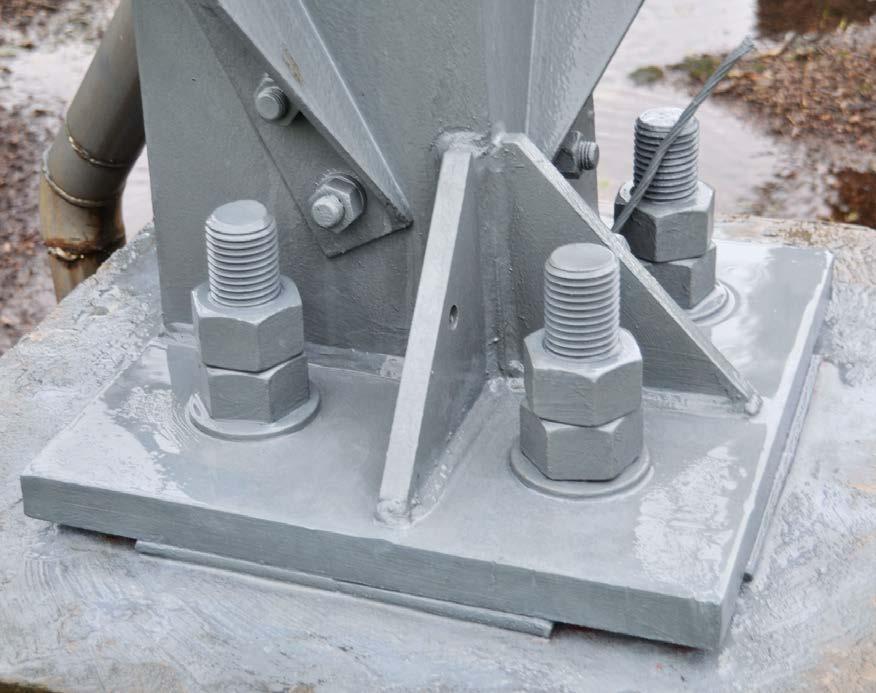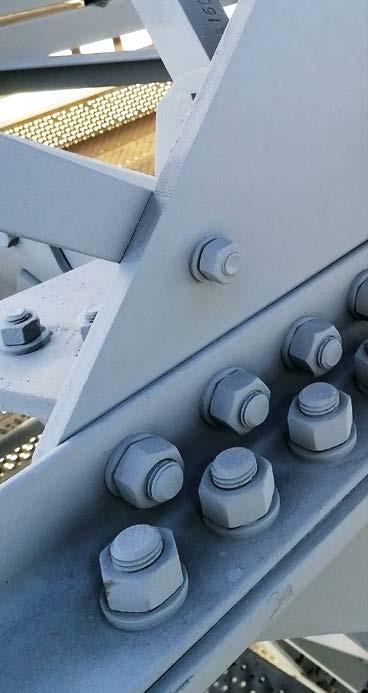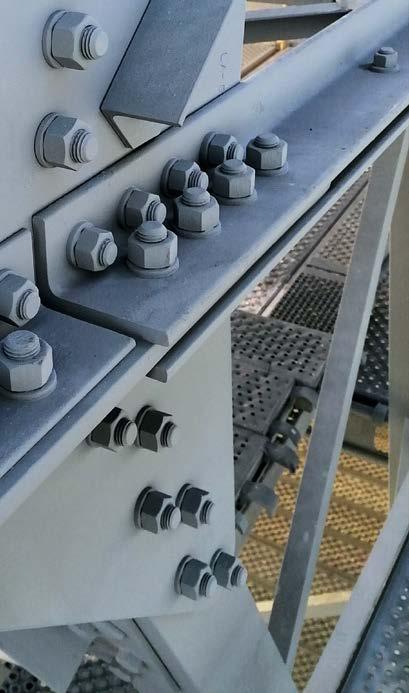
9 minute read
INNOVATIONS: PRESENT&FUTURE
SPECIAL ISSUE ON PROTECTIVE TECHNOLOGIES FOR BRIDGES, HIGHWAYS, INFRASTRUCTURES
Advanced Zinc Technology for Extending the Lifetime of Metallic Assets
Rick Simpson, Senior Corrosion Consultant
ZINGAMETALL Worldwide rick@zinga.eu
One of the most severe issues in ‘reloading’ old hot dip galvanised steelwork of electrical transmission pylons and structures is maintenance time. The Film Galvanising System was developed by Zingametall company so that these structures could be regalvanised in-situ without disruption that may compromise its operation.
Around 42 years ago a Film Galvanising (FG) System was developed in Belgium, specifically for the purpose or ‘reloading’ old or very weathered hot dip galvanised steelwork and this was aimed principally at electrical transmission pylons and structures like the catenary structures for supporting overhead electrical cables over railway tracks. This system had to be very pure zinc, and it had to have a matching electrical-potential to that of hot dip galvanising (HDG) as well so that it would not form a galvanic cell with the original hot-dip zinc.
The chemist who developed the FG system was a very forward-thinking person, as he knew that in the future years it would be either prohibitively expensive and/or virtually impossible to dismantle a corroded pylon and replace it once the zinc had depleted back to the bare steel. Such an act would cut off the power-supply to thousands of homes and businesses, and likewise to cut off the power-supply to the rail network would mean millions of commuters could not get to work (Fig. 1). Hence the Film Galvanising System was developed so that these structures and many other hot dip galvanised (HDG) structures could be re-galvanised in-situ with and with no disruption, or in some cases an hour or two of disruption at most so that people’s daily lives are not affected in any way. Like HDG zinc, the Film Galvanising (FG) zinc also depletes at a few microns per year, so there will never be flaking paint or troublesome residues to remove from the steelwork when the existing HDG or even FG zinc needs to be ‘re-loaded’ to restore the zinc thickness back to its original or similar thickness.
Depletion rates
The FG zinc is also like HDG zinc in that it depletes at different rates according to its geographical location, so where an electricity pylon is situated in high hills far away from the coast the zinc may deplete at only 0.1 µm per year, whereas at the coast being covered in salt-spray on a
© Zingametall daily basis it might deplete at 5 or 7 µm per year. The FG system can therefore be applied at the correct thickness to suit the particular location of the structure, and structures situated in high hills or in arid countryside may only require, for example, 90 µm DFT to last 30 – 40 years+, whereas near the beach they may require 120 – 150 µm DFT to obtain such an expected service-life. So contractors do not have to waste zinc where it is not required.
Re-loading old galvanising
Where electricity pylons and other important structures only have a thin, weathered layer of HDG zinc remaining on the steel surface, they are given a sweep-blast at 3 bars of pressure and using a nozzle-angle of 45°. This is so that the blast will roughen the HDG surface to provide a high adhesion-factor for the FG zinc, but without removing any the HDG zinc. The whole point of re-loading is to build-up the zinc. Where a galvanised structure has been neglected over the years and is showing areas of red rust, then these areas are fully blast-cleaned, again using a vapour-blaster (no dust is generated) and then the FG zinc is applied by brush, with second coats going on very fast using rollers (Fig. 2). As the FG zinc is generating over 1100 mV of electrical potential, the driving-voltage is very strong and the zinc galvanises the steel in the same way as HDG zinc, and so it complements its cathodic protection.
© Zingametall

Figure 1 - ZINGA® application at 45 m height. Figure 2 - Vapour-blasting an electricity pylon.

Dynamic adhesion values & electrical potential

Unlike zinc paints, the FG system uses a totally unique type of zinc, and one of its amazing characteristics is the dynamic adhesion values that it displays. After seven days of exterior exposure, this zinc will show an adhesion-value of around 5 MPa on a tensile pull-off test, and after three months this rises to around 7 to 9 MPa, and after one year or less it can rise to >10 MPa where it remains for the duration of the zinc’s service-life. Most zinc-rich paints will have an electrical potential of around 740mV – 780mV, whereas the FG zinc has a normal electrical potential of more than -1050mV. It has been proven that a minimum of -850mV is necessary to provide real cathodic protection. So, where steel has an electrical potential of 640mV, this represents a driving-voltage of around 430 – 450mV compared to that of zinc-rich paint which is 100 – 150mV, showing that the FG zinc has a cathodic protection current 3 x times higher.
Scandinavian weather
One big advantage of using the FG system in north-western Europe is that where the normal painting season is around May – August, this system can be applied all year round, unless it is physically snowing or raining. Even if it rains onto the zinc two hours after application (after hard dry), it will do no harm at all, and it can be applied onto steel in temperatures of -15 °C. This makes it a lot easier to plan painting programs each year, and there is no annual loss of half a year of maintenance work due to weather conditions.
© Zingametall

Systems tested
The FG system was tested in European testing laboratories to the ISO 12944 standard, and this testing revealed that when applied at a film thickness of only 120 µm DFT, it complied to the following standards: • ISO 12944 - C5 (VH): coastal atmospheric exposure with expected durability of 25 + years. • ISO 12944 - Im4: offshore immersion on wind turbines etc • ISO 12944 – CX: offshore atmospheric exposure • ISO 12944 - Im2: immersion in salt/brackish water • ISO 12944 – Im3: structures buried in soils.
Statnett regalvanises power masts on Karmøy
In Norway the organisation Statnett, who maintain the electricity transmission pylons for the national grid, are currently re-loading the HDG zinc on some pylons in one of their lines, and once again the versatility of the product has proven to be extraordinarily helpful in accessing tight
© Zingametall © Zingametall

areas such as bolted joints in order to load the old zinc layer literally everywhere on the pylon. The masts are sandblasted and treated with the FG system (Fig. 3). What is happening on Karmøy is historic: “Regalvanisation of entire masts is common in many countries, but this is the first time it is done in Scandinavia”, says Thor Smette, CEO ZINGA AS (Norway) and ZINGA Sweden AB. Statnett’s power line masts are mainly hot-dip galvanized steel masts. Hot-dip galvanizing is the best method of protecting steel from rust while keeping it maintenance-free and free for decades, but the protection does not last forever. The rust protection breaks down at a stable speed. The degradation, which in the technical language is called the sacrifice, is measurable. The pace depends on local conditions. Zinc is broken down faster along the coast and in industrial areas than inland without the impact of salt from the sea and industrial pollution. In Figure 4 it can be seen that a multicomponent bolted joint has been successfully re-loaded, including all of the nuts and exposed bolt-threads. The first pylon to be coated with the FG system (Fig. 5) was fully ‘tented in’ due to its close proximity to the offices of Statnett, and it can be seen that the old and weathered galvanising has been given a sweep-blast in preparation for the re-loading. Transmission pylons are normally never tented in, because it is initially an unnecessary cost added to the project, but more importantly the new blasting technology using vapour-blasters as opposed to traditional grit-blasting equipment means that there is no dust during the blasting operations, and the wet abrasive normally drops directly below the tower. So the clean-up phase is very fast. Depending on the abrasive used, it has been seen on several pylon sites that no clean-up was required, because the abrasive blends in with the surrounding ground as it is a silicate-based abrasive with natural colours that do not stand out.

From left to right:
Figure 3 - Pylon-base in Norway which has been re-loaded.
Figure 4 - A multi-component bolted joint has been successfully re-loaded, including all of the nuts and exposed bolt-threads.
Figure 5 - The first pylon to be coated with the FG system.
© Zingametall © Zingametall

Figure 6 - A typical Norwegian pylon design. Figure 7 - In Costa Rica FG system (ZINGA®) is used by ICE on remote towers.

In Figure 6 can be seen a typical Norwegian pylon design. This allows one side of the pylon (one electrical phase) to be switched off for a few hours while maintenance work is carried out. The other side remains ‘live’ and it is always “tagged-out”, which means that large red plastic tags are attached to the live side of the tower at various heights to let engineers know what side it to be worked on and what side is “live”. In this manner, the percentage of power customers can only lose their power for four or five hours whilst the remaining customers can continue to have power to their homes and offices. In locations where blasting is not possible HDG can also treated with mechanical tools like rotative brushes or flap disks. As this is a manual operation, the time needed for preparation will be longer. Life expectancy depends also on the degree of cleanliness, so extra care must be taken to clean the surface. A good example of such method can be found in Costa Rica where ICE (Instituto Costarricense de Electricidad) is using ZINGA® to treat remote towers by using wire brushes and clean water as surface treatment. According to Diana Venegas, Project Engineer at Tecnosagot (Costa Rica), the first pylons treated in 2010 are still in a good shape. The pylon in Figure 7 is close to an active volcano, so it receives all the fumes. ‹
The author would like to thank Thor Smette, CEO ZINGA AS (Norway) and ZINGA Sweden AB for his input about the Statnett power masts on Karmøy in Norway and Diana Venegas, Project Engineer at Tecnosagot.










